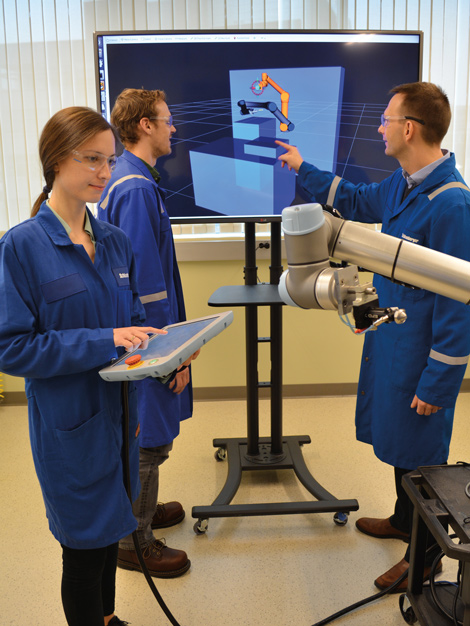
Roboticist Anastasia Mavrommati, Research Scientist Gavin Strunk, and Intelligent Manipulation Program Manager Chris Bogath implement path planning and grasping software changes in a flexible manufacturing demonstrator at the Schlumberger-Doll Research Center in Cambridge, Massachusetts.
Schlumberger has always held the conviction that research is an investment in its future and an essential part of the company’s culture. The first Schlumberger research laboratory, founded in 1948 in Ridgefield, Connecticut, focused on a scientific research program assembled by scientist Henri-Georges Doll. The objective of the program was to invent new subsurface measurements that would expand the growing Schlumberger wireline business.
In 1967, the laboratory was renamed the Schlumberger-Doll Research Center in honor of Henri-Georges, who was then the retiring chairman and had been the foremost technical contributor at Schlumberger. In 2007, the center moved to a new facility in Cambridge, Massachusetts, to be closer to a major research hub, including world-renowned universities such as the Massachusetts Institute of Technology (MIT) and Harvard University.
In January 2017, the Schlumberger-Doll Research Center added a robotics department that leverages digital technologies to address the challenges of oilfield operations—from subsea and surface to flexible manufacturing. The rise of robotics and artificial intelligence has sparked a remarkable industrial transformation, and adopting the use of robotics in the oil and gas industry provides another opportunity to reduce operational costs while further improving service quality and safety.
The Schlumberger robotics department works closely with academic institutions in Boston and industrial partners around the globe to adapt emerging robotics technology, such as perception, reasoning, communication, and manipulation, to enable system automation for oilfield applications.

The three stations shown of the Manara production and reservoir management system control the production characteristics of an individual zone. Produced fluids, noted with green for oil and blue for water, flow through a screen to the station where pressure, temperature, flow rate, and water cut are measured.
Saudi Aramco had a vision and commitment to develop technology that would take hydrocarbon recovery to a new level. Named after the Arabic word for lighthouse, the Manara system is the result of an eight-year collaboration between Saudi Aramco and Schlumberger.
The Manara production and reservoir management system is an intelligent completion system for multizone, multilateral, extended-reach, and Extreme Reservoir Contact wells. Combining 30 patented technologies, the Manara system provides permanent downhole pressure, temperature, water cut, and flow rate monitoring as well as in-lateral flow control of zones in real time.
The information derived from a conventional completion system typically permits engineers to make production decisions in days or weeks. The Manara system’s real-time permanent monitoring reduces the decision-making time to hours. This means reservoir workflows that commonly required three to six months can now be performed in one day. Integrated workflows from multiple disciplines create a collaborative work environment, where the identification and correction of problems in individual zones are made in real time. Rig time is reduced by optimizing a zone-by-zone cleanup procedure that also minimizes health, safety, and environmental risks.
The Manara system uses fewer parts than a conventional completion system. Electric power and downhole data pass through an inductive coupler that can service any number of well junctions. One electric control line connects through the wellbore to the wellhead via a single penetration.
Saudi Aramco’s Dhahran Advanced Research Center coordinated user requirements and, in conjunction with Schlumberger Engineering, developed a qualification testing program to de-risk the enabling technologies in the Manara system. This included extensive field testing in multiple Saudi Aramco wells. The Schlumberger focus on the transformation themes of technology, reliability, efficiency, and integration was important for the successful collaboration with Saudi Aramco.